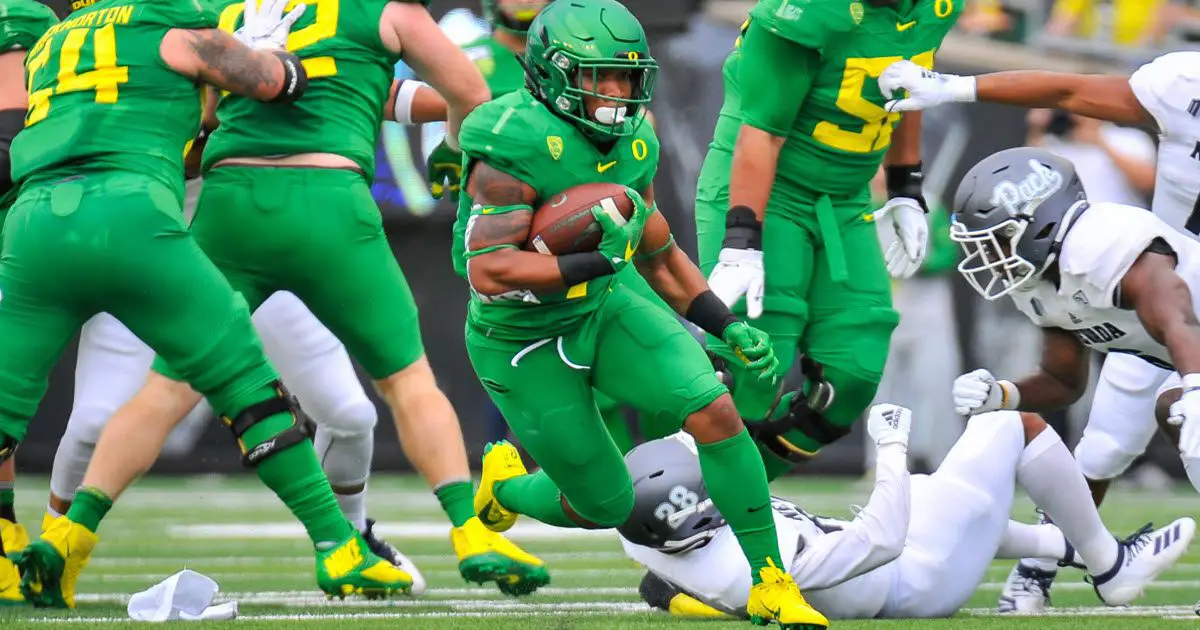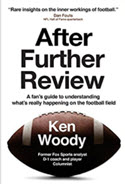A bye week gives Oregon players time to heal and coaches time to fix problems that may have reared their heads in the first third of the season, which finds the Ducks at three wins and one loss. They should, however, be 4-0, as they gave away the opener against Auburn in the last minutes after leading most of the game.
Everyone is in a dither about the running game, or lack thereof: Coach Mario Cristobal says the backs need to be more patient and that there has been some fall back from last year’s attack that featured two freshmen running backs who rushed for over 1,700 yards and an offensive line that returned intact to pursue the Moore Award, given to the top offensive line in college football.
With a third of the season gone, it’s clear that the offensive line will have to dig deeper and get better just to be the best offensive line in the Pac-12. Fans are faced with the fact that the days of 200-yard rushing games, once routine for Oregon, are gone. The Ducks led the league in rushing for 10 straight years through three different head coaches, but during that time they had better, faster running backs and some key linemen who are still playing in the NFL.
Before too many jump ship, it will be helpful to look at three of the nation’s top playoff-eligible teams and compare Oregon’s offensive statistics with Georgia, Alabama and Clemson. The Ducks average 458 yards per game, Georgia 509, Alabama 555 and Clemson 485. Each team has played a couple of patsies.
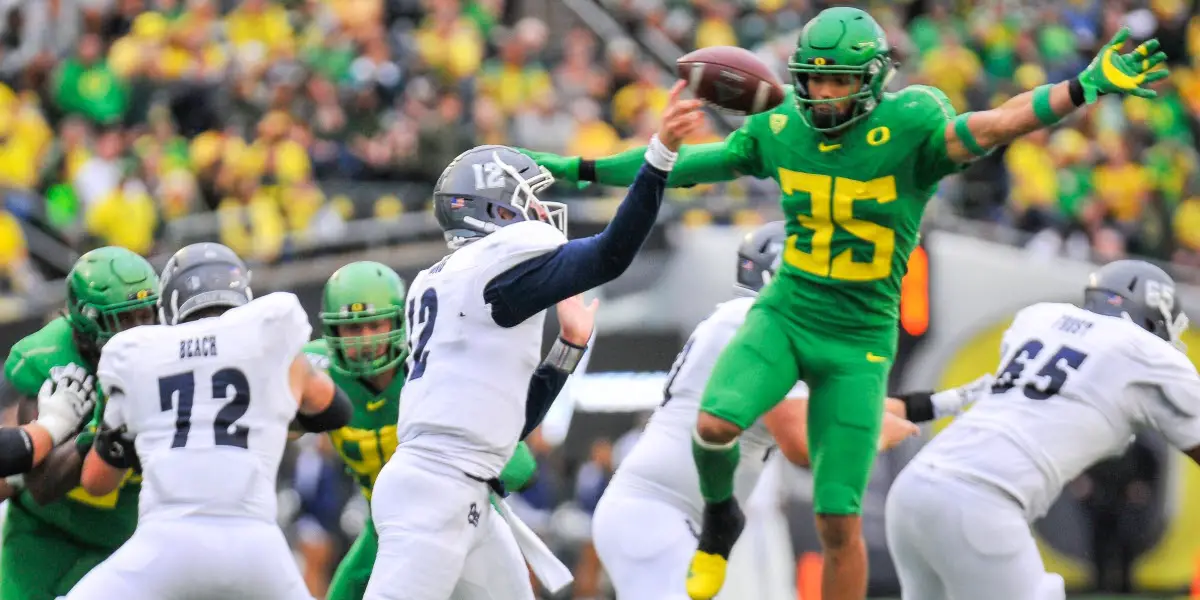
Troy Dye and the defense have kept Oregon close.
Rushing the ball, the Ducks are averaging 155 yards per game, Georgia 253, Alabama 174 and Clemson 222. Passing totals per game are Oregon 304, Georgia 256, Alabama 381, and Clemson 263. Ironically, Oregon may have played a slightly tougher schedule, facing Auburn and Stanford. Georgia beat its most difficult opponent Notre Dame by six points. South Carolina was Alabama’s toughest test, which Bama beat by 24. And Clemson topped North Carolina 21-20 and Texas A&M 24-10.
Running backs CJ Verdell and Travis Dye together are averaging 96 yards per game. Alabama has two backs who together are averaging 106 yards. Clemson’s top two average 140 yards per game. And Georgia’s top two average 146 yards. There are no Heisman candidates in this group, but the Duck twosome, statistically, is not far off from Alabama’s backs. Clemson and Georgia have about 50 yards on both the Tide and Oregon.
Fifty is the same goal Cristobal established for his offense’s third-down conversion rate, which is stuck at 39% presently and will not prevail in the Pac-12 North. The fourth-down conversion rate is 55%, which might seem okay, but it isn’t. The 45% that isn’t converted equals an offensive turnover of possession, something Cristobal seems willing to accept more than giving his field goal kicker some work.
Freshman kicker Camden Lewis is 0-2 on field goals, although one of the misses was the fault of Oregon’s left guard who overstepped his right foot inside the center’s and deflected the snap away from the holder, who made a great recovery to snatch the ball and keep it from being a scoop and score for Stanford. After the game, Cristobal commented that he still expected the kicker to regain his balance and steps (as he had moved to his right to catch the snap), and make the kick.
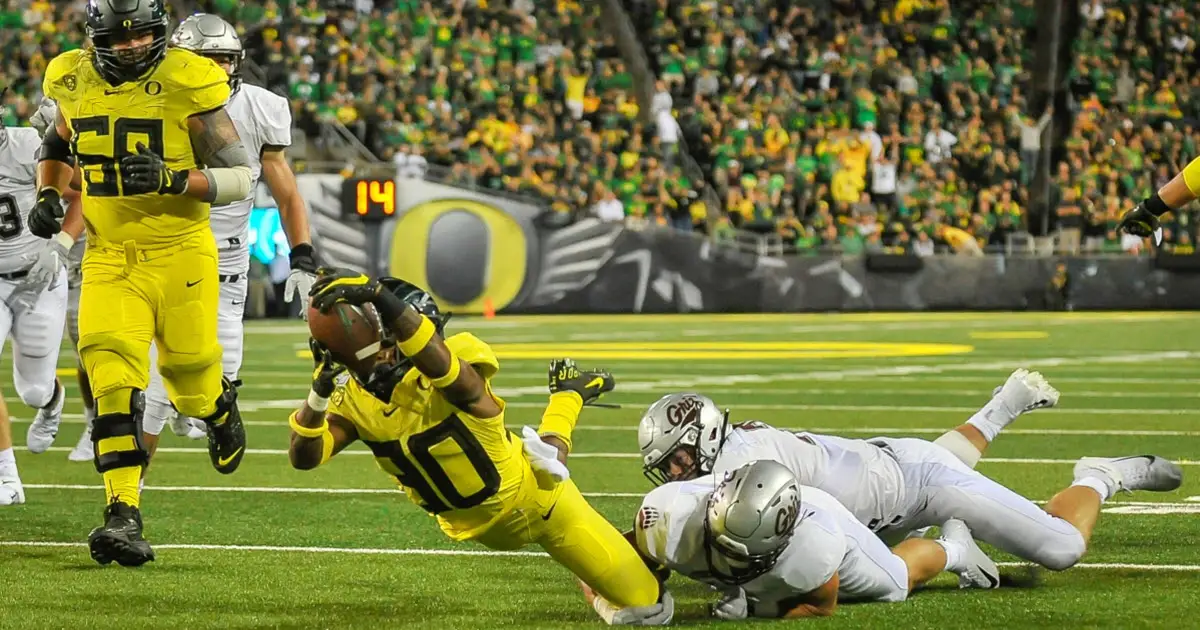
Did the Ducks need another touchdown?
Obviously, Cristobal is not a soccer style kicker; would you expect an offensive lineman to start a drive block with his shoulders back, weight on his heels? I don’t think so. Though the Ducks rung up 77 points on Nevada, coach could not find an opportunity of trying a couple of field goals instead of meaningless touchdowns to give the new kicker some work and confidence.
In the Montana game, facing a fourth-and-five on the Griz 25-yard line with a three touchdown lead in the fourth quarter, Cristobal chose to try and convert with an offensive play because “there was still football to be played.” As long as the game’s name starts with the word “foot,” field goals will be important — they win games for championship teams. Oregon would have been in the national championship game if they had a field goal kicker who could have successfully kicked routine-distanced kicks against USC in 2011 and Stanford in 2012.
Alabama’s field goal kicker has had nine opportunities in the five games the Tide won by an average of 40 points, Georgia’s had five tries in two games won by an average of 40 points, and Clemson’s kicker had five tries in three games won by an average of 40 points.
A game you are going to win handily is an opportunity to give your kicker some badly needed reps — the same kind of reps a coach gives every other position player on the team: it’s a standard for preparation. Suffice to say, Oregon’s field goal capacity — the snap, block, hold and kick — is unknown going into the final two-thirds of the season.
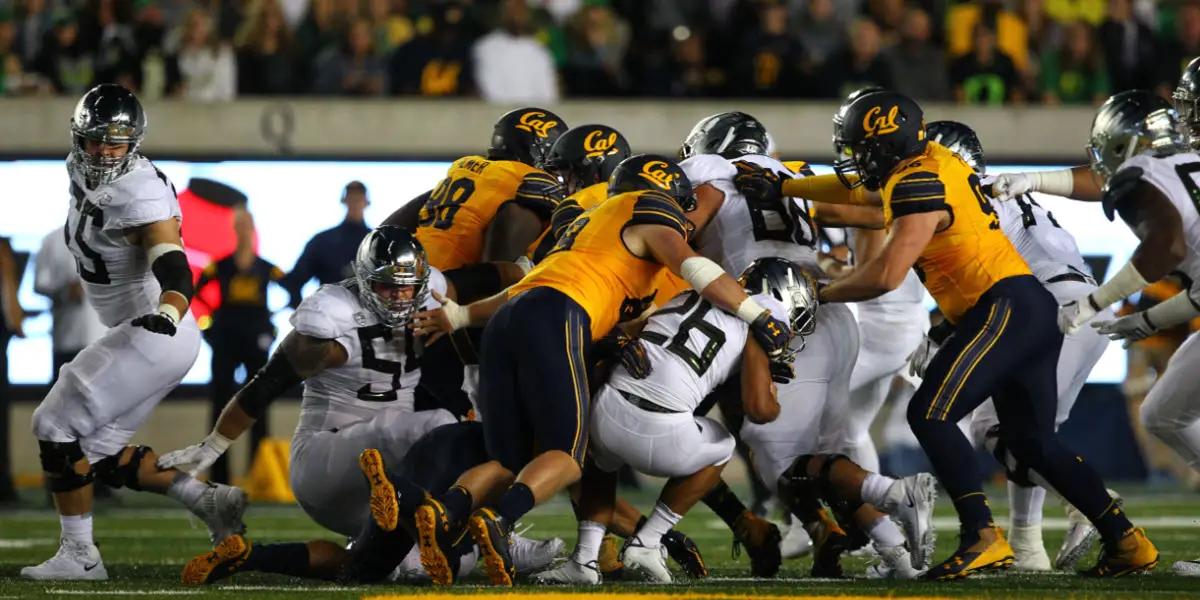
Running the ball against Cal has been tough sledding before…
The Duck offensive line has allowed eight sacks this season: four against Stanford along with several quarterback hurries, two of which resulted in quarterback Justin Herbert fumbling. Although Herbert recovered both, you could visualize how a key game could turn around with a turnover, especially on the road.
Against the Cardinal, the offensive line struggled to protect Herbert and showed they are not automatic at picking up routine pass stunts. Part of the problem, perhaps, was that the first team center was out and a couple of players were playing different positions, but it showed that the depth Cristobal had spoken of, may not actually be that deep or talented.
The Ducks have won a conference game on the road (only the fourth in the last three years), and they are slated for three more toughies: Washington, USC and Arizona State — all of whom have tougher defenses than Stanford. Although Cristobal chose to play the game conservatively against the Cardinal, the Ducks performed well, giving no turnovers and having only two penalties. This is an area of strength at present.
Last season, Duck receivers took a large portion of the blame for the dismal passing attack, deservedly; this year a new receiver coach has demonstrated that expertise and experience can make things look a lot different. No longer is the receiving corps a weakness compared to other offensive elements.
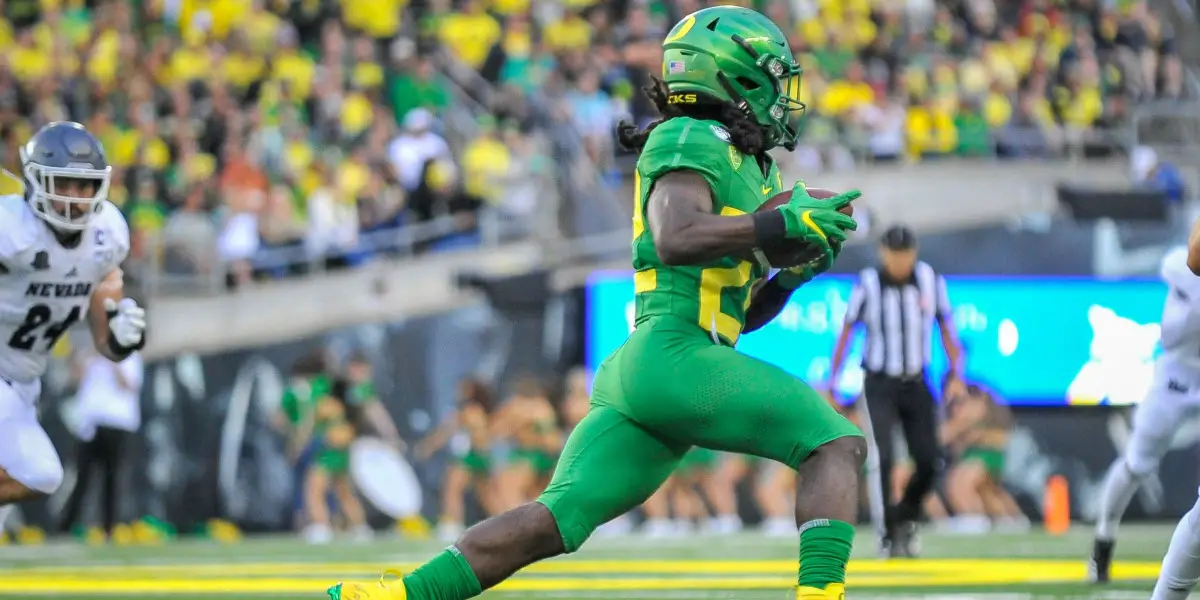
Felix has a high upside…
Oregon has more speed than it shows: the fastest back on the team, Darrian Felix, should be given the ball more, especially on the outside. Back in the day, Duck offensive teams attacked defenses on the flanks, from the very beginning of the game. As defenders tired, they were much more vulnerable to the kind of inside game Cristobal and the offensive line dream of. As it is, the running backs available are lightweight — cruisers where you need battleships.
The running offense is stale, and even fans who haven’t seen a lot of football complain that the play calling is boringly conservative. Cristobal’s primary focus in running the ball seems to be between the tackles where the offensive line has yet to establish a powerful push.
In one press conference he said defenses were loading the box and the Ducks needed to find a way to still make yards there. Many other coaches would see it differently — if the defense is overloaded somewhere, take advantage of it somewhere else, pass or run. If the running backs are expected to run over a tackler to make a gain, let it be wider, in the open field, where they might have more options to beat the tackler.
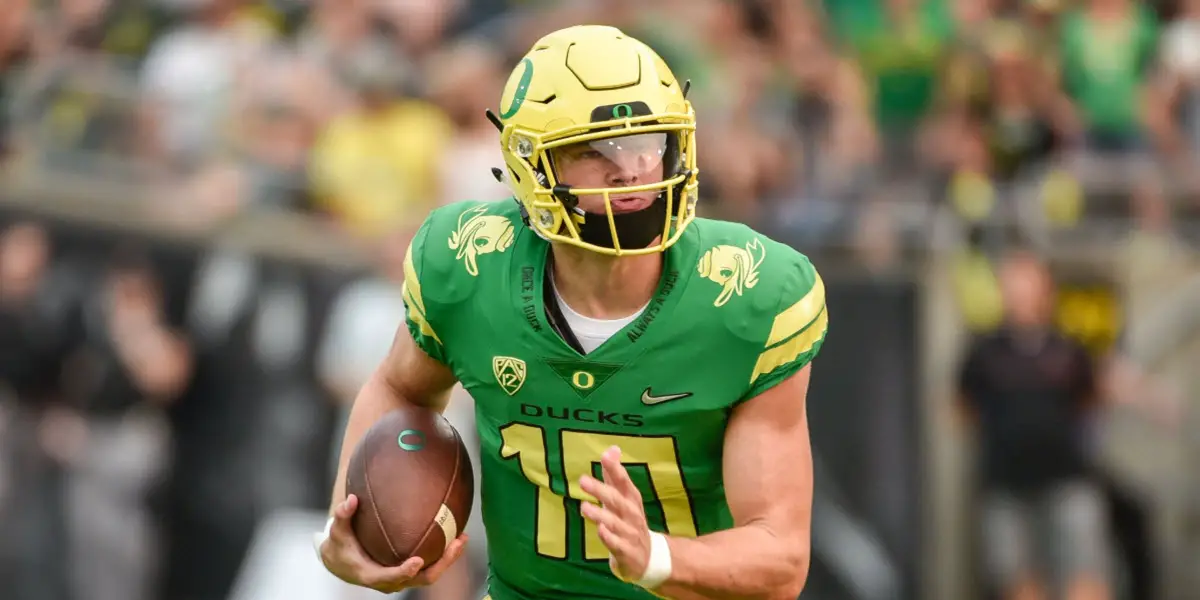
Justin Herbert has made some good gains — even TDs — by running.
Speaking of options, run one once in a while. Herbert is also the biggest back the Ducks have, and the fact that Cristobal’s team does not have the ability to have him under center to sneak the ball on short yardage does not make sense: “It’s not us,” commented the offensive coordinator. Critics might also point to past games (defeats) where a shotgun snap was not working due to weather (wind and rain) like against Oregon State, or crowd noise like against TCU in the Alamo Bowl.
Oregon’s centers have not had a great record for snapping the ball back consistently when the pressure amps up in the red zone or when an injury takes place. At times, if Herbert had been three to four inches shorter, a center snap would have zoomed over the quarterback’s head. It seems reasonable to be prepared for the worst, in case the worst happens. When you’re not, as in the Alamo Bowl (12 botched snaps), it’s very embarrassing for the coaching staff, not to mention the fans.
The next third of the season features three home games and only one on the road: one in Seattle to take on a physically tough Husky squad. New defensive coordinator Andy Avalos has the Ducks playing solid, tough defense. It will be interesting to see how that holds up against the dangerous passing teams of Colorado, Washington, USC and Washington State.
With some basic improvements and a successful October, coach Cristobal’s Ducks could be in good shape to make a serious run at the division and conference title.
Coach Ken Woody
Eugene, Oregon Top Photo by Matt Zlaket
Want to learn from Coach Woody in person? He will be analyzing the prior game each week this season at the 6th Street Grill in Eugene on Wednesdays from 6:00 to 7:30 PM with video analysis and opening it up for questions. Join him and learn more football! Charles Fischer

Natalie Liebhaber, the FishDuck.com Volunteer Editor for this article, works in the financial technology industry in Bozeman, Montana.
Dan Fouts, NFL Hall of Fame, Oregon Ducks quarterback: “Entertaining and easy to understand.”
“Every Oregon fan should have a copy to learn from as I do.” Charles Fischer
Buy the book here to learn from Coach Woody, or give a gift of football, a great gift for the fan who wants to learn and enjoy more of the Duck (or whoever your favorite team is) football experience.
Ken Woody is a former Fox Sports football commentator who played defensive back, receiver and kicker for Oregon from 1966 to 1970. He coached college football for 18 years, including stints as an assistant coach at Oregon, Washington, Washington State and Utah State, and was head coach at Whitman College and Washington University-St. Louis. He writes x’s and o’s, a weekly column in the Register-Guard, RG online coverage of Duck football and is the author of “After Further Review—an inside look at what’s really happening on the football field.” Woody is on KUGN (590 am) 2:45 before kickoff and 30 minutes after each game with coaching and game analysis.
Related Articles:
Ducks, Cristobal Answer Nagging Questions: Are the Ducks for Real?
Ducks Hang on in a Rough Ride with Fresno State
Cristobal: "Time to Coach 'Em Up"
"For Real"-Finally, Cristobal Unleashes Herbert in the Red Rose Zone
Coach Woody Analysis: Run Game Evolution and Opportunistic Defense Stun Utes
Coach Woody Analysis: Ducks Need More than the Pistol to Beat Utah
“I learned football working under many great coaches, among them Len Casanova, Jerry Frei, John Robinson, Bruce Snyder, George Seifert,and Ron Stratten at the University of Oregon, Jim Owens at the University of Washington and Jim Walden at Washington State University. Most of my coaching experience was on the offensive side of the ball with quarterbacks, receivers and kickers although as a head coach I coached defensive backs, linebackers and offensive line.
I achieved my first goal of being the youngest head coach in college football at the age of 26 and throughout my career in coaching and outside of it, as a journalist and broadcaster, have experienced how exciting and gratifying it is teaching the game to others.”

